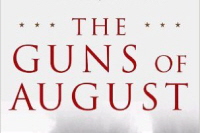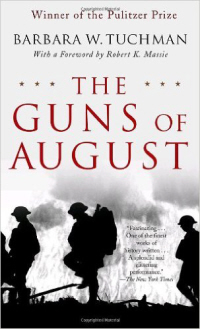
Book Review: The Guns of August
 The Guns of August, by Barbara W. Tuchman, copyright 1962. ISBN 978-0-38623-6, 640 pages, five stars.
The Guns of August, by Barbara W. Tuchman, copyright 1962. ISBN 978-0-38623-6, 640 pages, five stars.
How could a seemingly civilized and settled world suddenly erupt into a bloody, four-year-long riot of mechanized massacre called the First World War? This is the question I asked as I picked up Barbara Tuchman’s The Guns of August. Focusing on the first month of the Great War – August 1914 – this historical account explains what started the world’s debacle. The book focuses on the Western Front and the Russo-German front, describing – from a political and martial viewpoint – the plans, outbreak, and first battles of the Great War.
Tuchman’s history reads more like a novel than a history book. While the beginning of World War I is a highly researched topic that has been studied extensively, the book seeks to bring the well-studied depth of a scholar’s knowledge to the popular sphere. Ms. Tuchman is a phenomenal writer, descriptive, and well-researched. While names and dates are all too common in historical writings, this history describes the character, look, and actions of individuals in a compelling manner.
It is easy enough to write history for the public when you imagine what your characters were thinking and feeling. The Guns of August aspires to include all those trivial details and actually figure out what they were. As the author’s note indicates, “all conditions of weather, thoughts or feelings, and states of mind public or private, in the following pages have documentary support.” The ‘documentary support’ mentioned is nearly exhaustive; the end of the book contains pages and pages of books, journals, and records that support every statement in the book. Still, the writing remains fresh and interesting, describing in vivid detail all the happenings of great cities and great men in a time of great chaos.
I suggest that the reader of this book keep a map handy in order to track the progress of the armies and orient to the geography of the war. Without such visual aids it is difficult to remember who is where and what is happening. Several excellent maps, included in the book, will help with this. While The Guns of August does an excellent job in preventing the reader from becoming lost in a sea of names and treaties, it is an almost superhuman task, and sometimes the tactical decisions, diplomatic inquiries, and political figures begin to all look the same. While this is not common, it can and does happen from time to time in the book. Skimming through a few paragraphs will bring the reader back into the action.
All things considered, The Guns of August is a thorough, engaging, and informative history of August 1914 that will hold readers spellbound while giving them a much deeper understanding of the Great War’s causes. I read this book to understand why the world descended into the First World War; the why was not given to me, but the how is clearly explained, and as I thought about this book, I even began to understand some of the why. Anyone who has the same questions should read this book, as well as anyone who has an interest in the First World War or wants to understand history better. Writers will value this book as a pattern for how to write engaging and interesting historical accounts, and all who want to understand the world better – or, for that matter, anyone who wants an engaging and informative read – should pick up this book.



